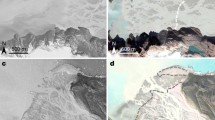Abstract
Among the distinctive characteristics of arctic deltas is the presence of snow, ice and permafrost. In many other aspects arctic deltas differ little from deltas found elsewhere, i.e. they have distributaries, sand bars, mudflats, sand dunes, subaerial and subaqueous portions and various kinds of lakes. Included among the unique forms in arctic deltas are ice wedges, ice-wedge polygons, pingos and thermokarst lakes.
The 600 km2 Colville River delta in northern Alaska illustrates well the forms and processes typical of arctic deltas and also illustrates the relationship between an arctic delta and its drainage basin, the ocean, the atmosphere and the biosphere. The drainage basin, which occupies about 1/3 of the North Slope of Alaska, is confined entirely to the continuous permafrost zone north of the Brooks Range. It is a region where snow cover (albeit generally thin) and river, lake and sea ice last for eight to nine months. During that period of time, geomorphic activity is minimal Hydrologically, the sea is connected with the river in the deeper parts of the river’s channels so that sea water penetrates beneath river ice some distance upstream during winter. In contrast fresh water flow during winter from the basin is virtually nil because of the frozen surface of water bodies and a frozen active layer which eliminates ground water as a source.
Snow melt, which generally begins in May, gradually leads to breakup. A pre-breakup flood period is followed by breakup and post-break flooding; combined they last about three weeks. During that period, flood water flowing against riverbanks can cause thermoerosional niching which often leads to bank collapse. The character of the bank collapse depends to a large extent on the texture and type of frozen bank material.
During breakup flooding, water flows over the bottom-fast ice of the river, into connected lakes and out to the sea. Much of the river’s suspended load is deposited in these overflow areas. As floodwater progresses out over the sea ice it eventually flows down through pressure ridge cracks and scour holes to progress seaward beneath the floating ice.
Being a low-lying area and being situated in the Arctic, arctic deltas are vulnerable to climatic and sea-level changes. Changes in temperature, snow fall, duration and extent of sea ice, and active layer thickness are among the many changes that would have major impacts on deltaic processes and forms.
Access this chapter
Tax calculation will be finalised at checkout
Purchases are for personal use only
Preview
Unable to display preview. Download preview PDF.
Similar content being viewed by others
References
Arnborg, L., Walker, H. J. and Peippo, J. (1966) Water discharge in the Colville River, 1962, Geografiska Annaler, 48A, 195–210.
Dawson, A. (1975) Landforms of the Colville River Delta, Alaska, as Interpreted from Aerial Photographs, Master’s Thesis, Louisiana State University, Baton Rouge, LA.
Peake, J. S. and Walker, H. J. (1976) Albedo decline in an arctic delta during spring snowmelt, Proceedings, Association of American Geographers, 8, 8–12.
Reimnitz, E., Rodrick, C. A. and Wolf, S. C. (1974) Strudel scour: A unique arctic marine geologic phenomenon, Journal of Sedimentary Petrology, 44 (2), 409–420.
Ritchie, W. and Walker, H. J. (1974) Riverbank forms of the Colville River delta, In: Reed, J. E. and Sater, J. C. (eds.) The Coast and Shelf of the Beaufort Sea, The Arctic Institute of North America, Arlington, VA, 545–562.
Veatch, J. O. and Humphreys, C. R. (1964) Lake Terminology, Water Bulletin No. 14, Michigan State University, East Lansing, Michigan.
Walker, H. J. (1983) The Colville River Delta, Section G: The Delta’s Distributaries,Report prepared for the North Slope Borough, 41 pp.
Walker, H. J. (1978) Lake tapping in the Colville River delta, Alaska, Third International Conference on Permafrost, Proceedings, 1, 233–238.
Walker, H. J. (1974) The Colville River and the Beaufort Sea: some interactions, in Reed, J. E. and Sater, J. C. (eds.) The Coast and Shelf of the Beaufort Sea, The Arctic Institute of North America, Arlington, VA. 513–540.
Walker, H. J. (1969) Some aspects of erosion and sedimentation in an arctic delta during breakup, Actes due Colloque de Bucharest, Association Internationale d’Hydrologie Scientifique, 209–219.
Walker, H. J. and Arnborg, L. (1966) Permafrost and ice-wedge effect on riverbank erosion, First International Permafrost Conference, Proceedings, National Academy of Science, Washington, D.C., PubI. 1287, 164–171.
Walker, H. J. and Harris, M. K. (1975) Perched ponds: an arctic variety, Arctic, 29 (4): 223–238.
Author information
Authors and Affiliations
Editor information
Editors and Affiliations
Rights and permissions
Copyright information
© 2002 Springer Science+Business Media Dordrecht
About this chapter
Cite this chapter
Walker, H.J. (2002). Landform Development in an Arctic Delta: The Roles of Snow, Ice and Permafrost. In: Hewitt, K., Byrne, ML., English, M., Young, G. (eds) Landscapes of Transition. The GeoJournal Library, vol 68. Springer, Dordrecht. https://doi.org/10.1007/978-94-017-2037-3_8
Download citation
DOI: https://doi.org/10.1007/978-94-017-2037-3_8
Publisher Name: Springer, Dordrecht
Print ISBN: 978-90-481-6037-2
Online ISBN: 978-94-017-2037-3
eBook Packages: Springer Book Archive




